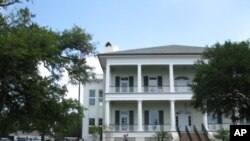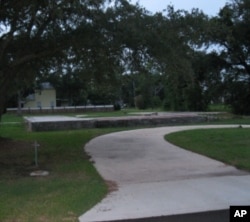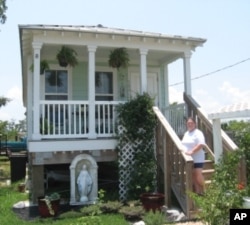When Hurricane Katrina raged across the Gulf of Mexico six years ago, it devastated the100 kilometers of the Mississippi coast. Houses, schools, libraries and hotels became piles of broken wood and windows.
Cars, trucks and boats were battered and tossed about. Entire neighborhoods disappeared. Thousands of residents and businesses left the state, but those who stayed are finally seeing a new landscape take shape.
A newly-built Southern mansion with tall white columns and a big porch overlooking the Gulf of Mexico is one sign Biloxi is rebuilding. It's the city’s new Visitors Center, which attracts local residents as well as tourists. Inside, a video tells of the hurricane that changed everything.
Slow comeback
Rebuilding is a slow and expensive process for a city built on tourism and the seafood industry.
Mississippi’s other coastal cities faced the same challenge. The federal government provided $25 billion for the massive effort.
Gov. Haley Barbour said the initial focus was getting coastal residents back into their homes. “About $4 billion has been dedicated to housing. We will, when we’re through, have either rebuilt or built or repaired more than 50,000 units of housing on the coast.”
Reviving the waterfront
Another major project, using federal money, is the $570 million renovation of the state port facility in Gulfport. Barbour said elevating the port and its container terminals to seven and a half meters, or 25-feet above sea level will protect not just the shippers, but the community.
“Twenty-five feet almost assures there’ll never be another storm surge that comes through here and sweeps all these containers that go into North Gulfport, West Gulfport and even into Long Beach and run over churches and houses and cars and land as far as eight miles away.”
Just east of that construction, the city of Gulfport is rebuilding its harbor for recreational boats. Mayor George Schloegel promises the revived waterfront will be even better than before Katrina.
“The recovery process has been very difficult. We stripped the entire harbor, went back to basics, every single piling was pulled out. We went to the basic structure and have built again, right from the ground," Schloegel says. "And we think we have built something that will be resistant to future storms. Not going to say storm-proof, but resistant.”
While cities can’t just move out of harm’s way, people can and many did relocate. Barb Corry moved to Biloxi a few months before Katrina struck to be near her son, who’s in the Air Force. Even though her house withstood the storm, Corry moved 160 kilometers north, saying she couldn’t face living through another hurricane.
“It was just disaster, trees all over. It was just like a bomb had went off. Most of the homes in our area, were just nothing left, just slabs, all the whole area was nothing but slabs, it was just sad.”
Staying on
But many on the Mississippi Gulf Coast won’t consider moving.
Cheryl Kring has lived most of her life one block from the beach in Waveland, about an hour east of New Orleans. She was a child in 1969 when her family home was destroyed by Hurricane Camille.
Then she and her husband lost their home to Hurricane Katrina. Now Kring is back on the same property, in a picture-perfect cottage.
“When it comes again - it’s gonna come again - and I’m gonna grab what I can grab and get out of here," says Kring. "And I will rebuild right back here again.”
Hurricane Katrina wiped out nearly all of Waveland. Half of the 8,000 residents left and never came back. But even two Category 5 hurricanes cannot destroy the connection Kring has to her piece of land.
“No matter what, I’m still coming back. No matter what, I will be on this corner. So it doesn’t matter. I love Waveland. I love the area that we’re in. It’s home. You can’t leave home.”













